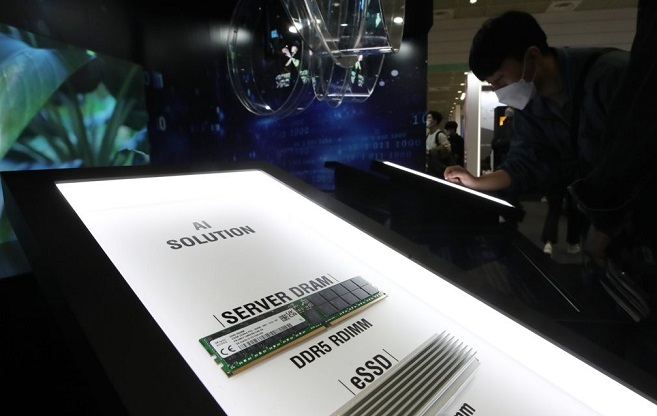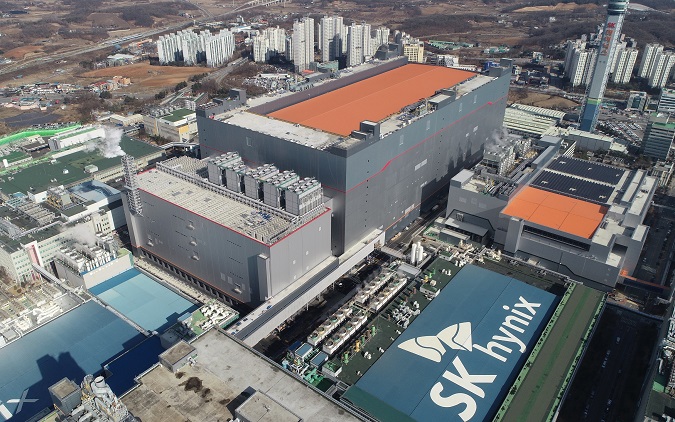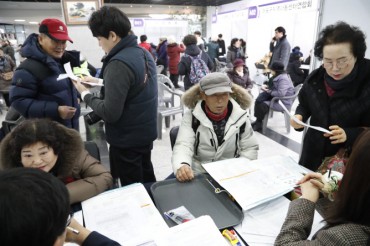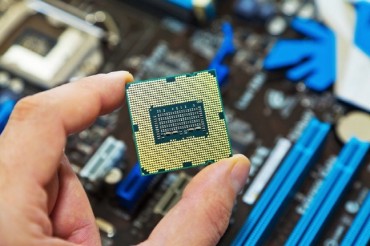
This file photo taken Oct. 20, 2020, shows the corporate logo of South Korean chipmaker SK hynix Inc. at its headquarters in Icheon, south of Seoul. (Yonhap)
SEOUL, Dec. 23 (Korea Bizwire) – The removal of the last regulatory hurdle for SK hynix Inc.’s acquisition of Intel Corp’s non-volatile memory business will likely accelerate the chipmaker’s plan to expand its presence and enhance competitiveness in the global NAND market, analysts said Thursday.
On Wednesday, the Chinese antitrust regulator gave the much-awaited green light for the South Korean company’s merger deal signed in October last year to acquire Intel’s NAND unit for US$9 billion.
The deal, the largest acquisition in South Korean history, includes the U.S. firm’s solid state drive (SSD) business and a NAND flash chip plant in Dalian, China.
The approval has brought the South Korean chipmaker one step closer to its goal of significantly reinforcing its NAND flash business to become the world’s second-largest player in the segment.
“The deal will enable SK hynix to achieve economies of scale in the memory market with high fixed production costs and to secure Intel’s technological prowess and its customer base,” Kim Sun-woo at Meritz Securities wrote in his latest report.
“But the massive spending for the deal could jeopardize the company’s balance sheet,” for the time being, which, he warned, can “strain its capital expenditure plan for its cash-cow DRAM business.”
Kim Kyung-min, a semiconductor analyst from Hana Financial Group, raised the target price of SK hynix to 165,000 won ($139) from 130,000, as she expected the performance of Intel’s NAND business, about 5-6 trillion won in annual sales, will be reflected in SK hynix’s earnings next year.

SK hynix’s chips are on display at the Semiconductor Exhibition held at the Coex Convention & Exhibition Center in Seoul on Oct. 27, 2021. (Yonhap)
Following the announcement of the deal last year, SK hynix obtained approvals from antitrust regulators in all seven countries involved up until July, except for China, raising concerns that the deal could fall victim to the on-going tech rivalry between the U.S. and China.
“There has been speculation that it would be difficult for SK hynix to win China’s approval for the deal, or any approval could be delayed significantly given the complex situation involving interests of various countries amid tensions between the U.S. and China for the semiconductor sector,” the company said in a statement.
It added that the approval came “at the right time without a significant delay as the deal is deemed mutually beneficial for all three countries.”
Now with the final clearance, SK hynix said it will focus on completing the remaining integration process, which is expected to continue until early 2025.
SK hynix is the world’s second-largest DRAM maker, with a market share of 27.2 percent in the third quarter, behind the dominant player Samsung Electronics with 44 percent, according to analyst firm TrendForce.
In the NAND flash market, it took up 13.5 percent after Samsung’s 34.5 percent and Japanese chipmaker Kioxia’s 19.3 percent.
Combined with Intel’s NAND business, which has a 5.9 percent market share, SK hynix will likely rise to the world’s No. 2 player in the segment.
In the SSD segment where Intel has a strong presence with 29.6 percent, SK hynix can take over Samsung with a combined market share of nearly 37 percent.

This file photo provided by SK hynix Inc. on Feb. 1, 2021, shows its M16 fab in Icheon, south of Seoul. (Yonhap)
The acquisition is also expected to rebalance SK hynix’s revenue portfolio, which is heavily dependent on DRAM. By sales, DRAM accounted for around 70 percent of the company’s total revenue last year, while NAND accounted for 23 percent.
In line with the chipmaker’s efforts to strengthen its NAND business, it joined a global consortium in 2017 to invest in Kioxia, then known as Toshiba Memory Corp., and injected about 4 trillion won (US$3.5 billion).
The consortium, led by U.S. private equity firm Bain Capital, owns about half of Kioxia’s stake.
The company has stepped up efforts to expand capacity abd diversify business portfolio amid the global chip shortages and intensifying competitions in the chip industry.
In February, the company completed construction of its new chip fabrication plant, M15, in Icheon, 80 kilometers southeast of Seoul.
It installed Dutch firm ASML’s extreme ultraviolet (EUV) lithography equipment there, for the first time in its factory, to produce the most efficient and advanced chips.
It also plans to build four additional chip fabrication factories in a semiconductor cluster in Yongin, south of Seoul.
The company said construction for its first new fab is expected to start in 2024, and mass production from that facility could be possible as early as 2025.
In October, it bought Key Foundry, a local 8-inch wafer foundry manufacturer, for 575.68 billion won (US$492 million), to double the company’s chip contract manufacturing capacity to around 200,000 sheets of wafers per month.
(Yonhap)






